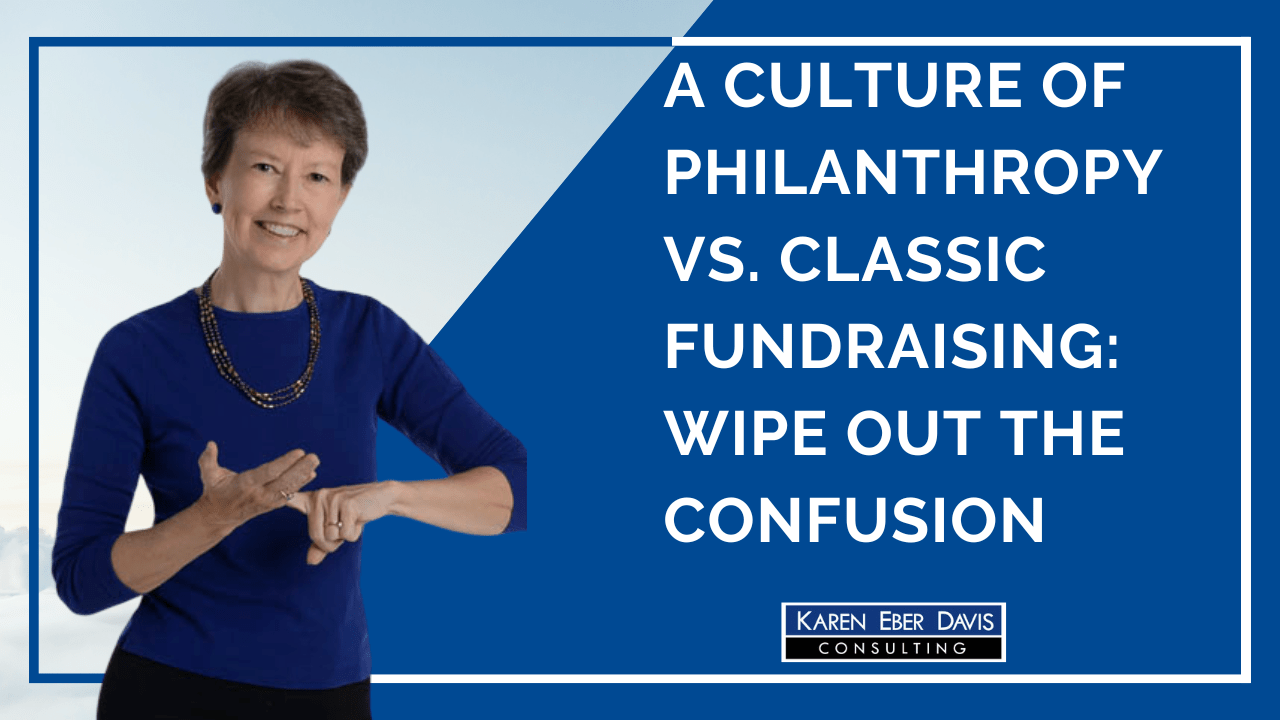
Culture of Philanthropy vs. Classic Fundraising? Wipe Out the Confusion
Nonprofit leaders, boards, and supporters get confused about the difference between a culture of philanthropy and classic fundraising.
Who can blame them!
Lots of crossover exist between the two concepts plus a truckload of fluff.
Most nonprofits claim they have a culture of philanthropy but get fuzzy when they explain how they measure it.
In this video, you will discover an explanation of the three fundamental differences between traditional fundraising and philanthropic cultures.
Transcript from Culture of Philanthropy vs. Classic Fundraising? Wipe Out the Confusion
This is Grace. She has a question about the difference between a culture of philanthropy and classic fundraising.
Great question, Grace. I’m so glad you asked because lots of people have this question. So here are the three fundamental differences.
Culture of Philanthropy Difference Number One
The first difference is that in a culture of philanthropy, donors are celebrated for the gifts they are making and that they have made. It is all about how wonderful what you have done is to help and support our organization. And these donors are not just your big major gift donors. They’re the little donors.
Versus classic fundraising. Unfortunately, often donors begin to feel like they are a cash machine and that everything you’re doing to steward them. It’s about working towards the next gift.
Difference Number Two
The second key distinction between classic fundraising and cultures of philanthropy comes about from who benefits from being philanthropic and enjoys the benefits. Instead of a few—the ten donors who give the majority of gifts, everyone is invited to be part of philanthropic giving and to receive the benefits.
“Ah,” Grace says, “I’m beginning to see the difference, but I have a question what kinds of benefits do donors receive?”
Thanks for that question, Grace.
The benefits are extensive. They’ve been researched. It brings happiness. It reduces social isolation, and importantly for a nonprofit it teaches people how social change is made, which leads us to our third key distinction.
Culture of Philanthropy Difference Number Three
Instead of begging people to give us money, in a cultural philanthropy, we create synergies, and these synergies include a loyalty. ‘I’m able to give and see that my gift makes a difference in the world. I want more of that.
We also see that collectively together, we can achieve amazing things, which is by the nature of why we create our organizations. And, of course, this all leads to more revenue and income for the nonprofit to do more of what they’re really, really good at.
Grace now begins to understand the difference between a culture of philanthropy and classic fundraising, and now so do you. For more, read and watch the resources in Karen’s Nonprofit CEO Library.
Karen Eber Davis is a nonprofit strategic planning consultant who works with visionary leaders committed to taking their organizations to new heights. She offers customized strategies, assessments, and coaching designed to help leaders lead their organizations to achieve their potential. She is the author of 7 Nonprofit Income Streams and Let's Raise Nonprofit Millions Together.
Categories
If you appreciate these Added Value posts, please consider subscribing.
Latest Posts
- How New Nonprofit CEOs Secure Board Buy-In for Strategic Planning
- How Nonprofit Leader Navigate Crisis with Clarity & Confidence
- One Way AI Can Help You Find a Path Where None Exists
- In Crisis? Resist Cutting Your Ability to Make Income
- Nonprofit Strategic Planning Assessment: 10 Questions to Strengthen Your Strategy
